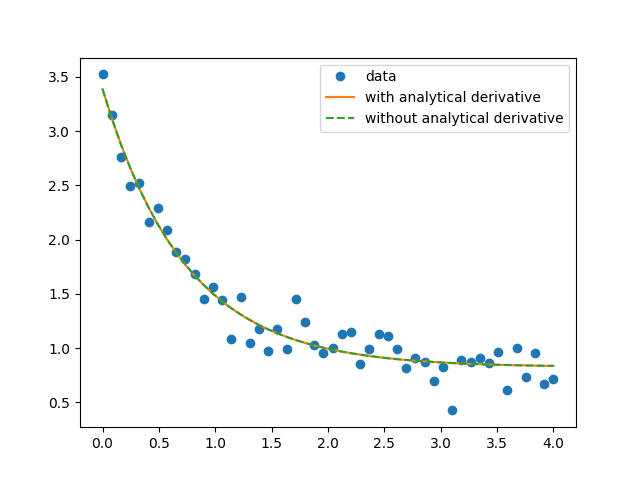Note
Go to the end to download the full example code.
Fit Specifying a Function to Compute the Jacobian¶
Specifying an analytical function to calculate the Jacobian can speed-up the fitting procedure.
import matplotlib.pyplot as plt
import numpy as np
from lmfit import Minimizer, Parameters
def func(pars, x, data=None):
a, b, c = pars['a'], pars['b'], pars['c']
model = a * np.exp(-b*x) + c
if data is None:
return model
return model - data
def dfunc(pars, x, data=None):
a, b = pars['a'], pars['b']
v = np.exp(-b*x)
return np.array([v, -a*x*v, np.ones(len(x))])
def f(var, x):
return var[0] * np.exp(-var[1]*x) + var[2]
params = Parameters()
params.add('a', value=10)
params.add('b', value=10)
params.add('c', value=10)
a, b, c = 2.5, 1.3, 0.8
x = np.linspace(0, 4, 50)
y = f([a, b, c], x)
np.random.seed(2021)
data = y + 0.15*np.random.normal(size=x.size)
Fit without analytic derivative:
Fit with analytic derivative:
Comparison of fit to exponential decay with/without analytical derivatives to model = a*exp(-b*x) + c:
print(f'"true" parameters are: a = {a:.3f}, b = {b:.3f}, c = {c:.3f}\n\n'
'|=========================================\n'
'| Statistic/Parameter | Without | With |\n'
'|-----------------------------------------\n'
f'| N Function Calls | {out1.nfev:d} | {out2.nfev:d} |\n'
f'| Chi-square | {out1.chisqr:.4f} | {out2.chisqr:.4f} |\n'
f"| a | {out1.params['a'].value:.4f} | {out2.params['a'].value:.4f} |\n"
f"| b | {out1.params['b'].value:.4f} | {out2.params['b'].value:.4f} |\n"
f"| c | {out1.params['c'].value:.4f} | {out2.params['c'].value:.4f} |\n"
'------------------------------------------')
"true" parameters are: a = 2.500, b = 1.300, c = 0.800
|=========================================
| Statistic/Parameter | Without | With |
|-----------------------------------------
| N Function Calls | 39 | 12 |
| Chi-square | 1.0920 | 1.0920 |
| a | 2.5635 | 2.5635 |
| b | 1.3585 | 1.3585 |
| c | 0.8241 | 0.8241 |
------------------------------------------
and the best-fit to the synthetic data (with added noise) is the same for both methods:

Total running time of the script: (0 minutes 0.308 seconds)
